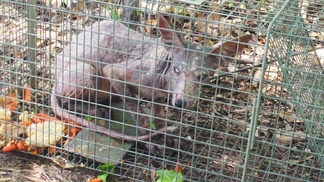Prince Chupa = Mangy Canid
Posted by: Loren Coleman on August 16th, 2011
This week the “Mystery Beast” stalking Prince George’s County, Maryland, since June 1st, was captured briefly, so it could be photographed. (Prince George’s County is a county located in the U.S. state of Maryland, immediately north, east, and south of Washington, DC. As of 2010, it had a population of 863,420.)
The animal is being called a “Chupacabras” by some locals, frequently seen near Prince George’s Hospital, and thus earned the label “Prince Chupa.” (Prince George’s Hospital Medical Center is located in Cheverly, Maryland.)
Some remarkably silly things are being quoted in the press about this animal:
“It’s a kangaroo, dog, rat mixed,” X-ray technician Joe Livermore said. “It’s got a rat tail and a head like a deer. I don’t know what it is.”
Livermore decided to trap it, photograph it, and release it. He passed along the images to the local media. Apparently no DNA samples were taken by the hospital technician.
The animal is obviously a canid with mange, a class of persistent contagious skin diseases caused by parasitic mites, which results in the loss of hair. Most often, the mange being seen in these so-called “Chupacabras” cases is caused by an infestation of Sarcoptes scabiei canis, a burrowing mite found in dogs, coy-dogs, foxes, and coyotes.

Credit NBC Washington.
A similar mangy canid was photographed near Joppa, Maryland, in 2004 (see below), and Prince George looks like a twin of the mangy dogs and coyotes misidentified as Texas and Oklahoma Chupacabras, at bottom, all the time.




About Loren Coleman
Loren Coleman is one of the world’s leading cryptozoologists, some say “the” leading living cryptozoologist. Certainly, he is acknowledged as the current living American researcher and writer who has most popularized cryptozoology in the late 20th and early 21st centuries.
Starting his fieldwork and investigations in 1960, after traveling and trekking extensively in pursuit of cryptozoological mysteries, Coleman began writing to share his experiences in 1969. An honorary member of Ivan T. Sanderson’s Society for the Investigation of the Unexplained in the 1970s, Coleman has been bestowed with similar honorary memberships of the North Idaho College Cryptozoology Club in 1983, and in subsequent years, that of the British Columbia Scientific Cryptozoology Club, CryptoSafari International, and other international organizations. He was also a Life Member and Benefactor of the International Society of Cryptozoology (now-defunct).
Loren Coleman’s daily blog, as a member of the Cryptomundo Team, served as an ongoing avenue of communication for the ever-growing body of cryptozoo news from 2005 through 2013. He returned as an infrequent contributor beginning Halloween week of 2015.
Coleman is the founder in 2003, and current director of the International Cryptozoology Museum in Portland, Maine.










Well the Maryland Goatman is definately not a mangy canid.
I’m starting to think that maybe these coyotes don’t actually have mange at all. After all, there are hairless dogs. I see no reason that coyotes couldn’t get the hairless gene through either crossbreeding with dogs or a random mutation.
Question, what is the Maryland Goatman?
It has become more than PAINFULLY obvious that the fabled “Chupacabra” was NEVER anything more than a canine with mange.
I remember that the first report of a Chupacabra and its description happened during the month that Species was released. It seems like a case of source confusion memory bias (not sure it that is the correct term) where the woman saw something unusual and constructed the memory based on recently accessed imagery, as far as the original description goes, then the description mutated culturally, now a Chupacabra resembles a canine with mange and is considered a cryptid.
It’s fascinating how stories are retold and change even within a single person. I think it is called leveling and sharpening which are memory biases.
its obviously NOT mange..
mange is caused by the animal scratching the fur off..which would mean tons of scabs and scratches on the skin. There would also be hair left where he couldn’t reach with his paws..
Not sure if I remember the Maryland Goatman, but I definitely remember (old news accounts) the Snallygaster, in western Maryland.
Well the official name isn’t the Maryland Goatman, usually just the Goatman, but its a satyr-like creature that has been sighted in Prince George’s County, I think mostly around the “Crybaby Bridge” on Governor’s Bridge Road in Bowie, as well as Texas. Look up the book “Weird Maryland” by Matt Lake.
As a veterinary technician that saw mange ridden canines day in and day out, I am VERY comfortable saying these are canines suffering from generalized Demodectic or Sarcoptic mange. The hair does not fall out from scratching, it comes out because the mange mites are living in the hair follicles and destroying them. There is another condition called atopic dermatitis that also causes the hair to fall out due to an out of control allergic response to environmental factors. These are all relatively common conditions and are seen on a daily basis in any veterinary hospital though usually not quite to this extreme, though it is far from unheard of. The darkening/blackening of the skin seen on these animals is characteristic of these skin conditions. If you look at some of those pictures, you can see lots of scabbing around the ears and faces of those critters, and that is a result of scratching. Finding these animals dead in the wild is not a surprise. Generalized mange to those extremes take a huge toll on the immune system and can lead to other systemic infections. In fact, the generalized mange itself is often a symptom of a suppressed immune system brought on my a myriad of factors, including other parasitic infections or malnutrition. Trap one of these guys alive, treat him with Ivermectin for a few weeks and I guarantee you that the hair will grow back and the so-called Chupacabra will again be a coyote or fox.
I think there is a genuine and interesting phenomenom here not always to be explained by what seems most probable. Surely cryptozoology particularly enjoys dealing with animals for which there is evidence but also doubt and mystery, flying in the face of committed sceptics who mistake probability for actuality. Maybe there is a new animal here somewhere? Not to imply it would be THE chupacabras of recent times.
All four or five animals in the above pictures appear to be different to each other and have any of them been diagnosed with mange or is it an opinion based on a view of probability? No 2 appears to be the best candidate but with a hyena like appearance? No 4 looks similar to my late beloved whippet lurcher. No 1 looks really weird and I can understand Joe Livermores bemusement.
It is not out of the question that any of the animals above were geneticaly hairless and naturally grey like the ( otherwise disimilar) mexican hairless dog. They could presumably have mange, hairless or not, so skin damage doesnt neccessarily indicate they have lost hair via mange and might they might be something special?
No5 in particular looks quite healthy and unmarked with a natural skin colour and naturally hairless. It doesnt look like a fox or coyote because of its short ears and thick body and its teeth suggest it was a mature animal. Can’t help wondering if it could be a hairless south american bush dog or short eared dog? Which may have gone unoticed in certain areas not excluding north america. Unlikely but not impossible.